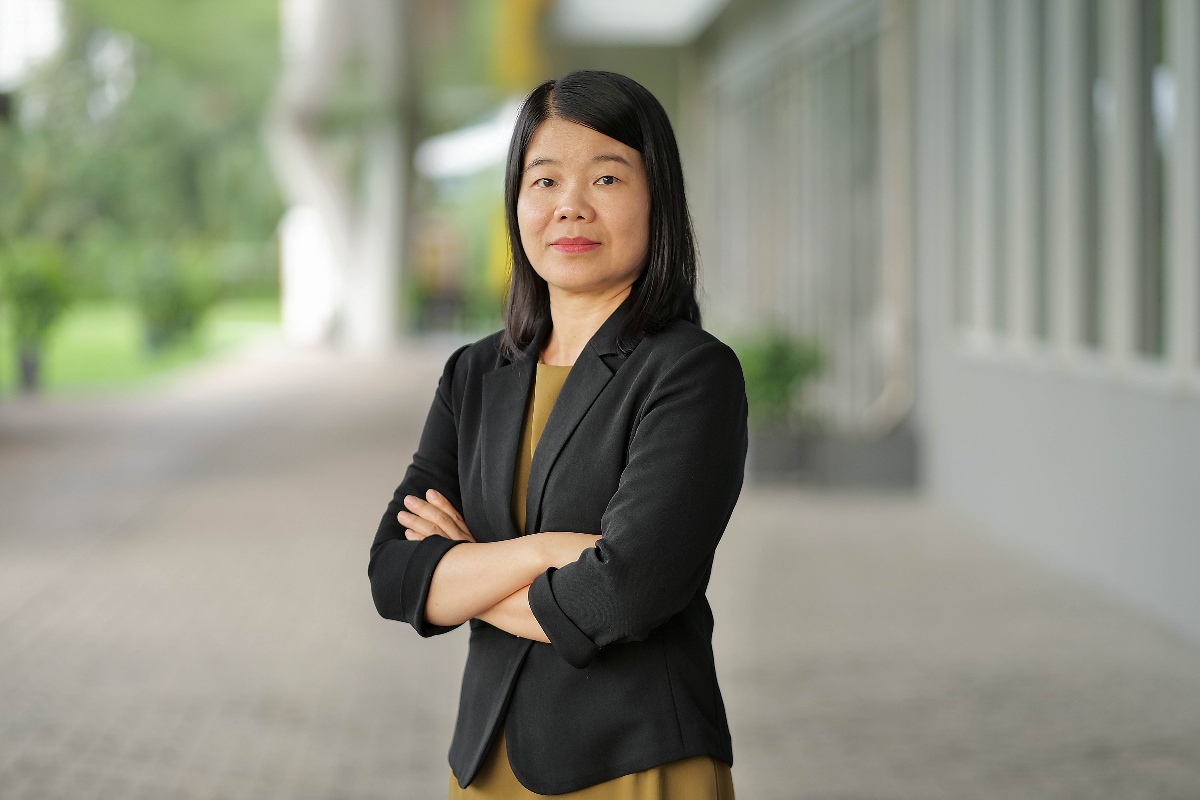
The global healthcare workforce crisis is deepening, with a projected shortfall of 11 million workers by 2030. Closer to home, Vietnam faces its own challenges: there are only 12.5 doctors per 10,000 people; its healthcare system is strained by aging demographics; and there is unequal access across urban and low-resource communities.
As part of our Vietnam 2050: The vision ahead series, we explore how life could look like for Vietnam over the next 25 years. In this article, Dr Thuy Nguyen, Senior Lecturer in Artificial Intelligence at RMIT Vietnam, shares a bold vision for how AI could transform Vietnam’s healthcare system by mid-century.
With deep expertise in machine learning and AI in healthcare, Dr Thuy examines how AI, quantum computing, and robotics could revolutionise prevention, diagnostics, and access, particularly for underserved communities. Her insights offer a compelling glimpse into what healthcare might look like in 2050: smarter, fairer, more connected and more sustainable than ever before.
Vietnam’s healthcare system is on the cusp of transformation. While urban centres benefit from growing digital infrastructure and specialist hospitals, many low-resource areas still face a shortage of skilled professionals and basic services. This divide is real but not irreversible.
“Artificial intelligence is emerging as a powerful equaliser. It has the potential to support diagnosis, streamline patient care, and extend the reach of medical services beyond traditional clinic walls,” said Dr Thuy. “It should be seen not only as a tool, but as part of the healthcare workforce of the future, helping to reduce the burden on medical staff, and extend access to remote areas.”
 Dr Thuy Nguyen believes AI can help expand access to diagnostics and telemedicine, especially in underserved areas. (Photo: RMIT)
Dr Thuy Nguyen believes AI can help expand access to diagnostics and telemedicine, especially in underserved areas. (Photo: RMIT)
Vietnam is still in the early stages of AI adoption in health. Applications include image-based diagnostics in radiology and pathology, with pilot projects detecting diseases such as tuberculosis and cancer. Telemedicine is expanding, connecting local clinics with central hospitals for assisting diagnosis, consultations and training.
Challenges remain. Medical data is fragmented, lacks standardisation and is not readily shared, limiting AI model performance. Infrastructure gaps, regulatory uncertainty, and a shortage of AI-literate healthcare workers continue to slow progress. Trust is another hurdle as many patients hesitate to rely on AI systems for diagnosis.
Still, momentum is building. In Vietnam, AI has already been piloted in disease screening and diagnosis through projects funded by the National Foundation for Science and Technology Development and a number of international collaborations. Telemedicine is shifting from a pandemic necessity to a long-term solution linking expertise to where it’s needed most.
Over the next 25 years, AI is expected to evolve from a support tool to a proactive partner in care. Dr Thuy believes that breakthroughs in quantum computing, robotics and hyperspectral imaging, combined with AI, will advance healthcare far beyond today’s capabilities.
 AI, quantum computing, and robotics are expected to drive safer, faster, more personalised, and affordable healthcare solutions in the future. (Photo: Toowongsa – stock.adobe.com)
AI, quantum computing, and robotics are expected to drive safer, faster, more personalised, and affordable healthcare solutions in the future. (Photo: Toowongsa – stock.adobe.com)
Quantum computing will accelerate drug discovery and personalised treatments. Hyperspectral imaging will enhance proactive, non-invasive diagnostics with highly accurate and personalised treatment. Combined with AI, these technologies can bring better prevention, early detection and targeted care even to remote regions.
AI will monitor patient health, predict risks and support tailored prevention plans. Robotic systems will automate repetitive tasks and assist with complex procedures, allowing doctors to focus on human-centred care.
“We may not be far from a future where virtual hospitals powered by AI deliver quality care across distances,” said Dr Thuy. “But technology alone isn’t enough. We must also invest in training, building reliable framework and trust for equitable access.”
Infrastructure, education and thoughtful implementation will be critical. AI should complement, not replace, healthcare professionals. Doctors will remain essential - not only for their clinical skills but also as humane, responsible and ethical stewards of machine-generated insights.
To make the most of AI’s potential, Vietnam needs systemic change. Dr Thuy emphasises the importance of investment in human resources, digital infrastructure and innovation. Clear and robust regulation to ensure safety, privacy and interoperability to facilitate healthcare transformation with AI is vital.
 Expanding digital infrastructure, innovation and AI education will be key to ensuring equal access to advanced healthcare across Vietnam. (Photo: Luciano – stock.adobe.com)
Expanding digital infrastructure, innovation and AI education will be key to ensuring equal access to advanced healthcare across Vietnam. (Photo: Luciano – stock.adobe.com)
Without action, the risk is a deepening divide - where only wealthier patients benefit from AI. A national AI healthcare fund could support innovation, trials and upgrades, especially in under-resourced areas. Insurance policies should be updated to cover AI-assisted diagnostics and remote care to ensure inclusivity.
The private sector must contribute by co-developing solutions, localising global innovations, and scaling access. International collaboration will help bring in technological expertise and investment.
“We need a whole-of-society effort - one that brings together government, industry and universities - to ensure AI in healthcare doesn’t become a privilege for the few,” Dr Thuy said.
Education is central. Vietnam must modernise training for both health and tech professionals, offering interdisciplinary programs in AI, health informatics, and digital mental health. Uplifting knowledge and skills through short courses and applied research will help building long-term capability.
Though RMIT Vietnam does not have a medical school at this time, Dr Thuy sees the university playing a strong role. With expertise in AI, emerging technology, and business, RMIT can train AI engineers, researchers, digital health innovators, and policy leaders. It can also serve as a hub for partnerships - connecting researchers, hospitals and startups to pilot AI solutions in real-world settings.
“We do not have a school of medicine, but we do have the expertise to power the digital backbone of future healthcare,” she said. “By investing in people, partnerships and research, we can support a healthcare system that is both innovative and inclusive.”
Beyond policy and infrastructure, Dr Thuy believes people will ultimately shape how AI transforms healthcare. “What excites me most is its potential to make health care more accessible, preventive, personalised and inclusive,” she said. “If I could implement one technology today, it would be an AI-assisted healthcare platform tailored for low-resource communities.”
To the next generation of healthcare leaders, she offers this advice: “Stay visionary yet practical, fostering continuous learning and building resilient systems. Embrace technology with courage, adaptability, interdisciplinary thinking and a mindset of curiosity and collaboration. Those who can bridge AI and medicine, with both empathy and technical fluency, will shape the healthcare systems of the future.”

Vietnam 2050: The vision ahead is a thought leadership series powered by RMIT Vietnam’s academic experts, exploring what Vietnam could become over the next 25 years. Each article unpacks potential major shifts – from smart cities and education to tech and entrepreneurship – offering bold predictions and practical ideas for a future-ready nation. Discover more insights here.
Story: Quan Dinh H.
Thumbnail image: Toowongsa – stock.adobe.com
Co-organised by the Ministry of Education and Training (MOET) and RMIT Vietnam, the Vietnam Education Festival on AI and Digital Innovation 2025 created a nationwide platform for teachers to connect, learn and share best practice.
While fraudulent returns and fake reviews have long plagued online retailers, a new twist is emerging: AI-powered return fraud.
From 10 December 2025, Australia is the first country to officially ban users aged under 16 from owning a social media account. RMIT experts discuss the potential implications of a similar ban in Vietnam.